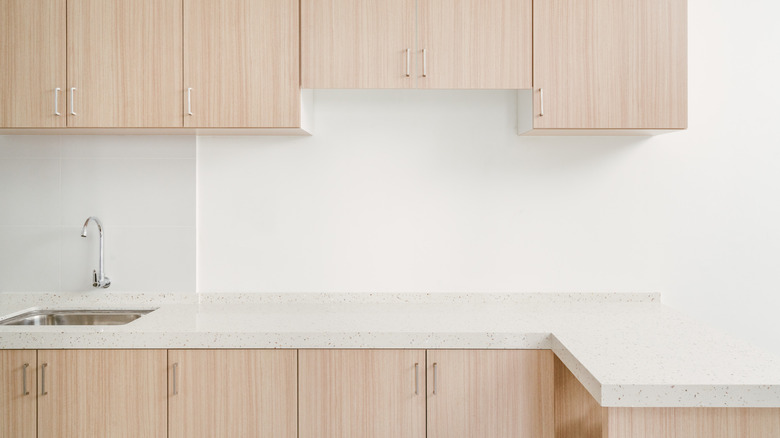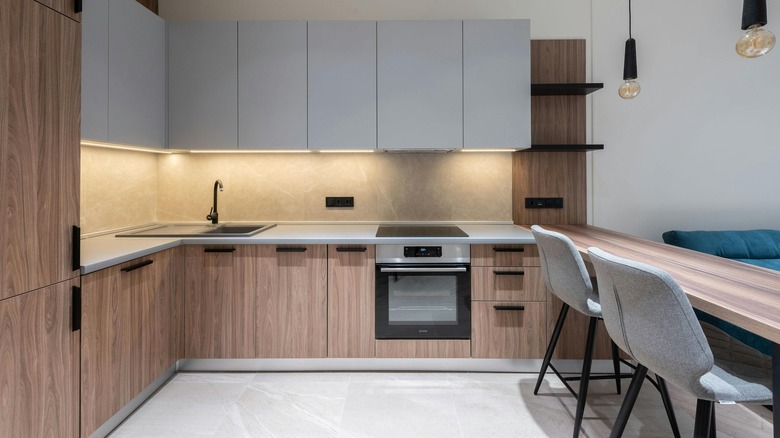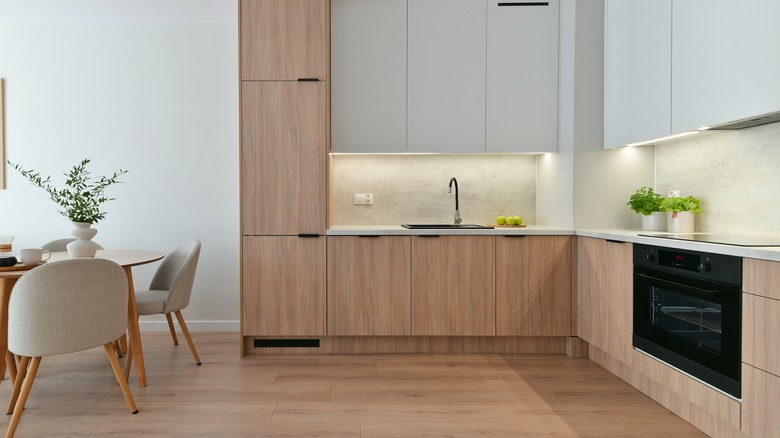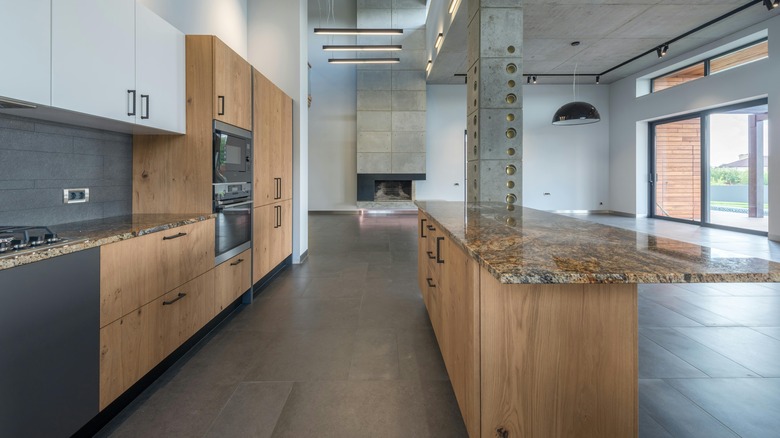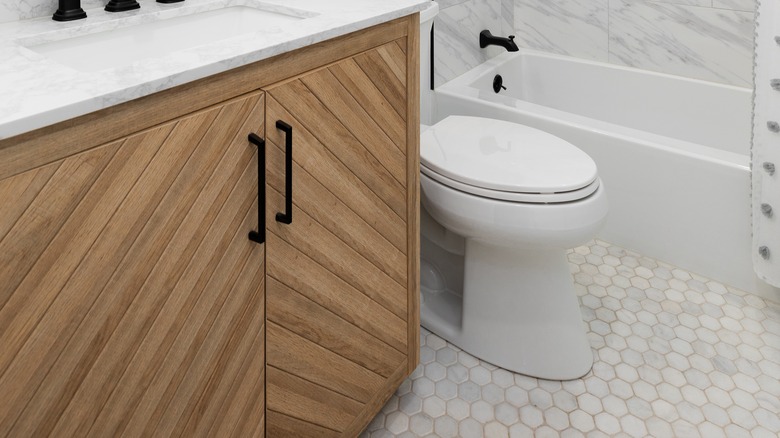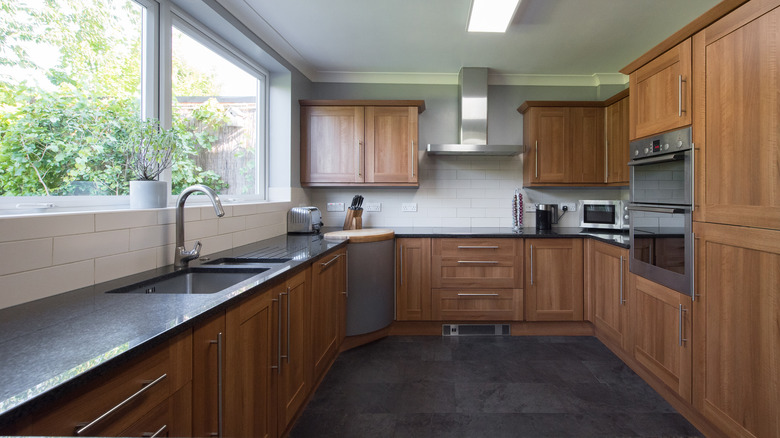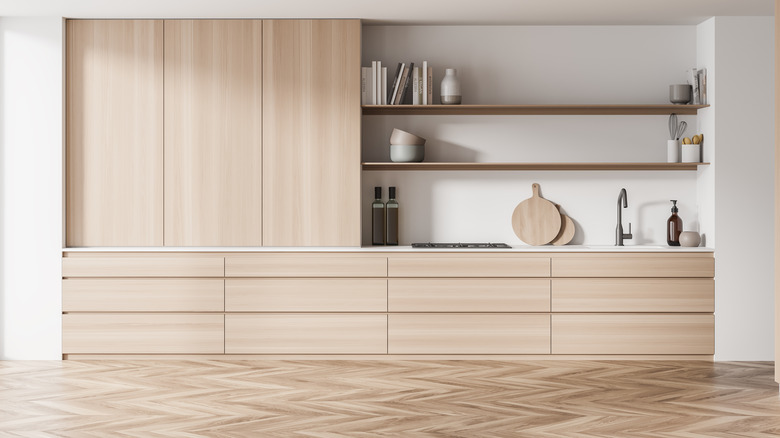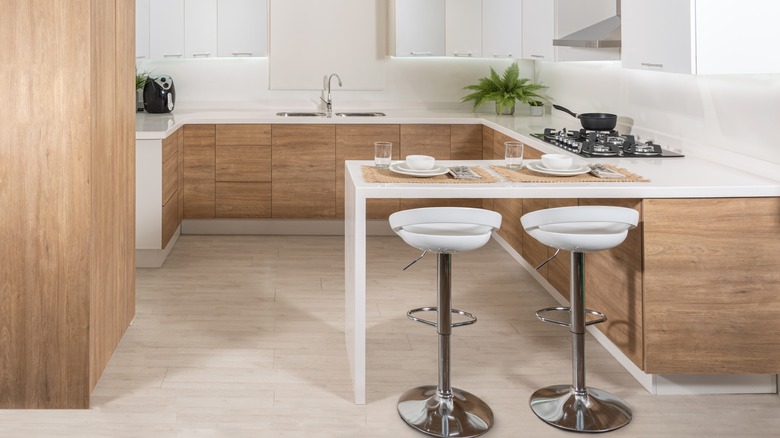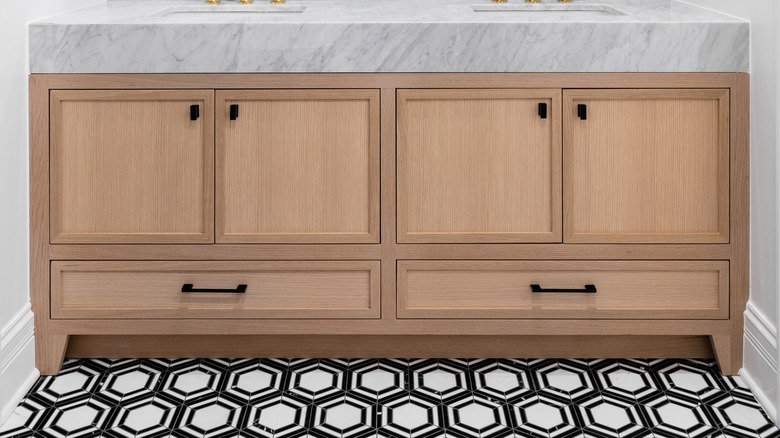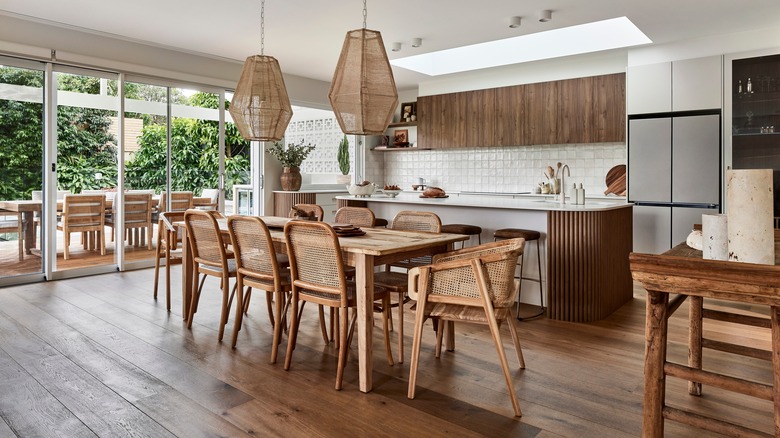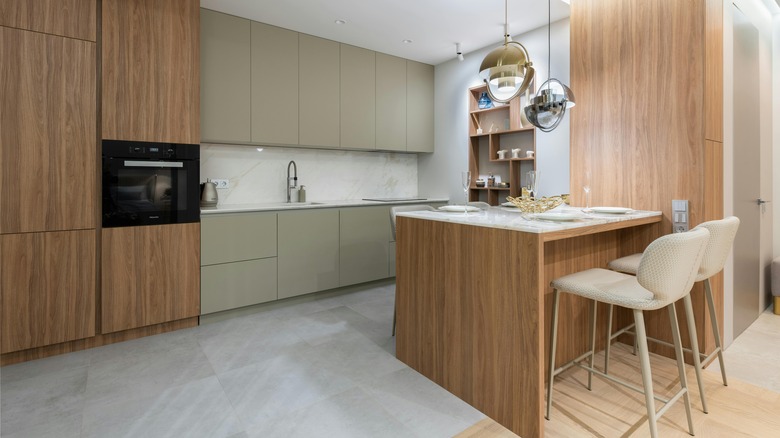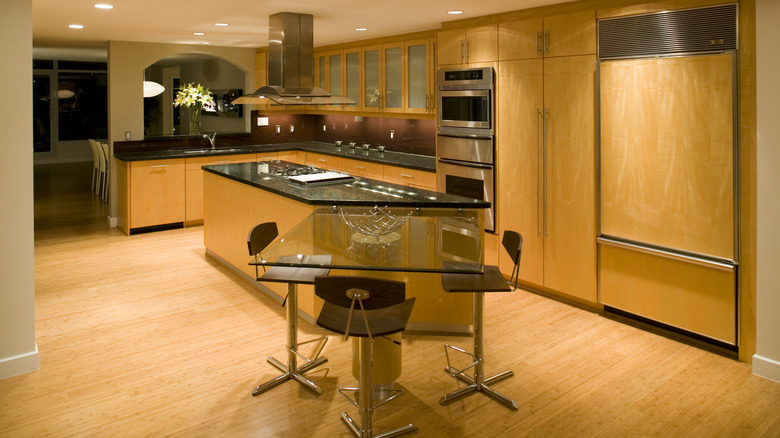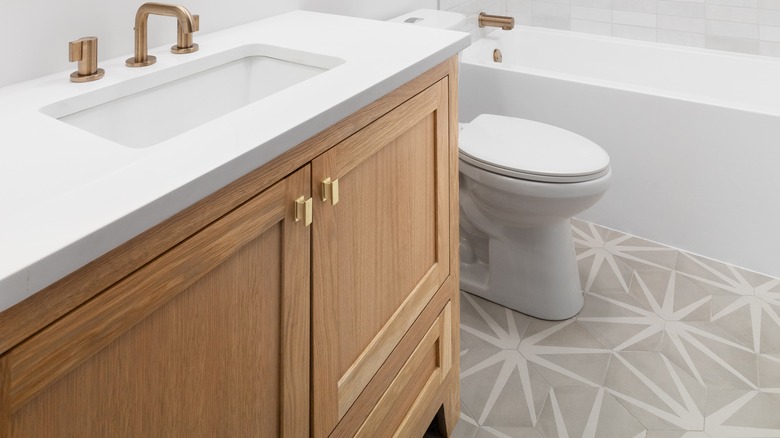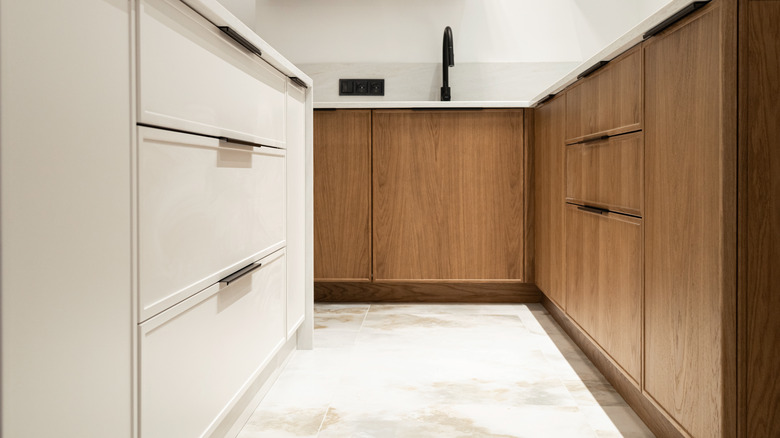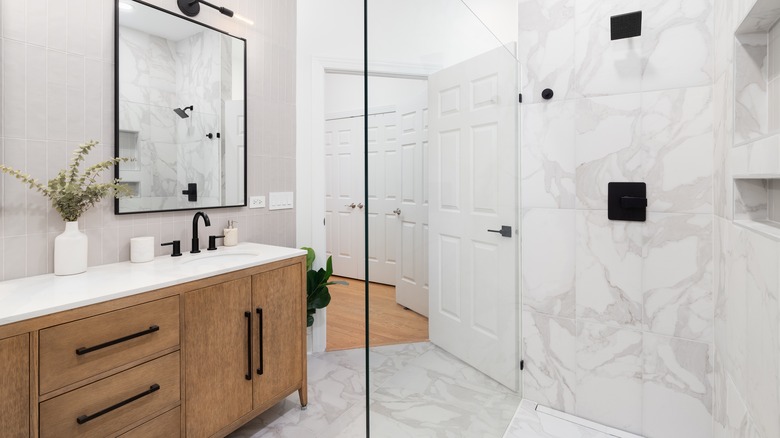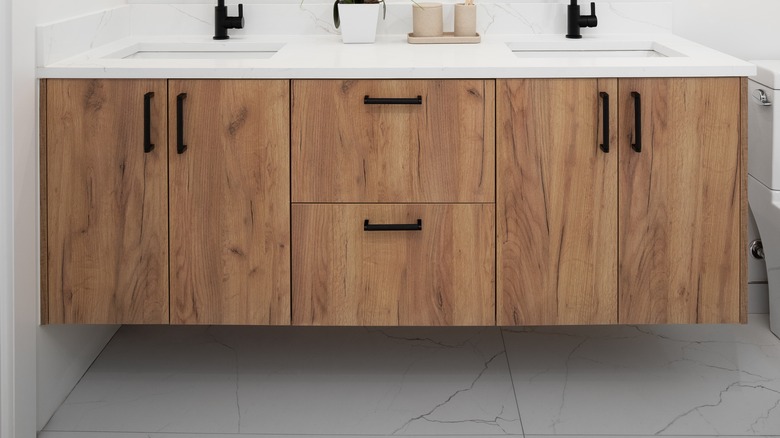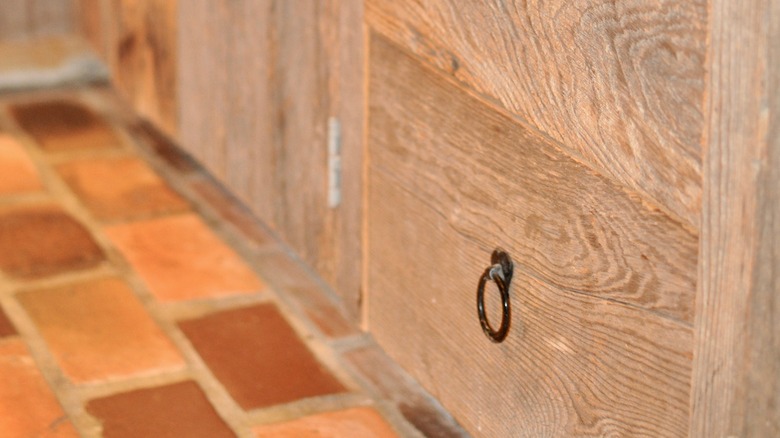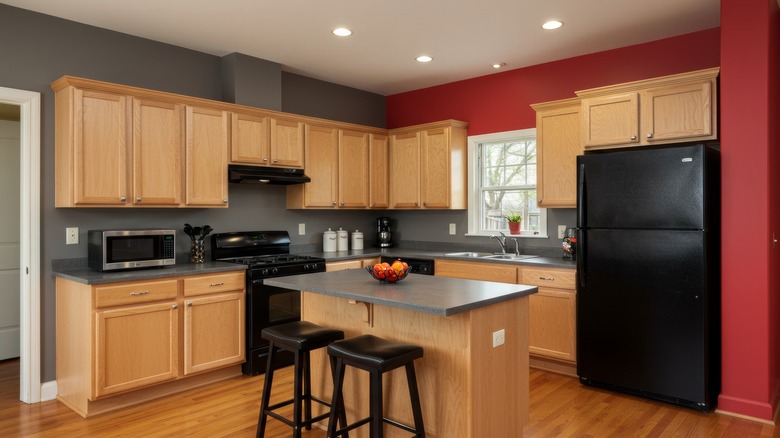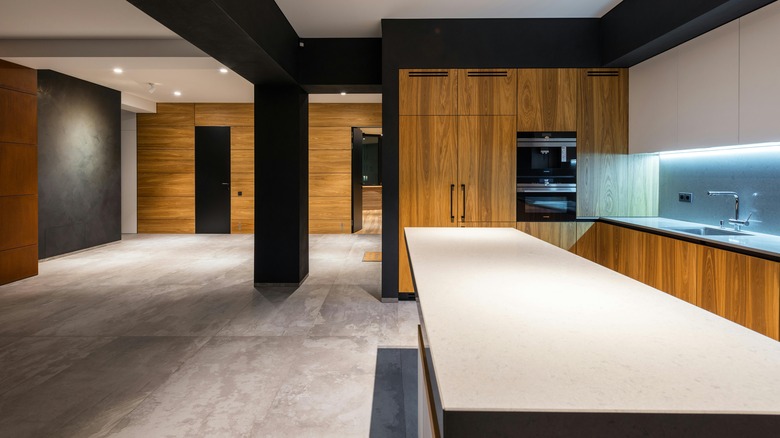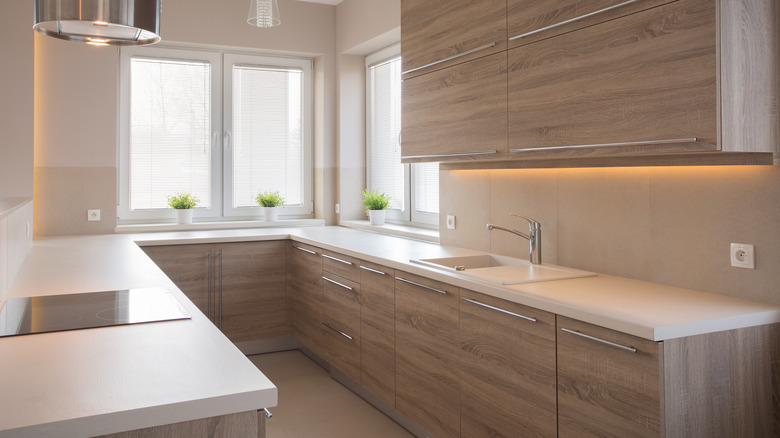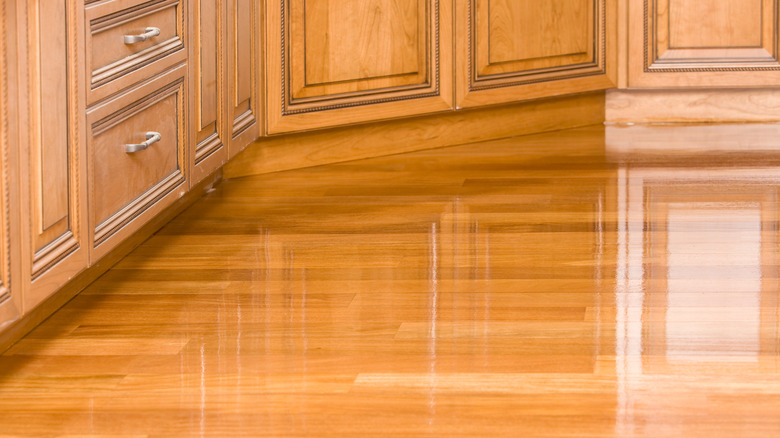20 Types Of Flooring To Pair With Trendy White Oak Cabinets
White oak cabinets are making a big comeback in modern home design, largely due to their sleek yet versatile appeal, durability in high-trafficked spaces, and objectively stunning grains and patterns. A golden, warm hue by nature, white oak's color in cabinet form can actually vary due to its undertones. Thus, when stained, the end result can range from a pale brown to richer chocolates to shades that look naturally bright. This adaptability makes it a more chameleon-like fixture in a space, despite its color-identifying name suggesting otherwise. White oak cabinets, therefore, can fit seamlessly into any design scheme. In fact, HGTV design darling Nate Berkus revealed it's the perfect cabinet material for a light and airy space.
The aesthetic and practical benefits abound. But once you decide on white oak cabinets, the real design challenge begins when want to you piece together all the different elements that make up the room's design. And one of the biggest choices you'll have to make is which floors pair with these trendy, yet timeless cabinet options. From white porcelain tiles for a crisp, clean look to dark hardwoods like walnut that evoke a high-contrast elegance, there is an abundance of options from which to choose to round out your white oak cabinet-based design.
Porcelain tile
Porcelain tiles in light neutral colors and white oak cabinets together evoke a crisp, contemporary aesthetic that can feel very much like a Scandinavian design-inspired space. In bathrooms, in particular, this pairing is luxuriously modern while still feeling cozy and peaceful; however, in kitchens, the combo feels sleek and smart. Regardless of which room you place this pairing, to round it all out, consider placing dried eucalyptus somewhere in the room or decorating with olive branches in sleek vases to add a sophisticated design touch.
Matching white oak
For an optimal tonal combination, you can't go wrong with using white oak for both your cabinets and floors. While some folks might be concerned that it may look too matchy-matchy, there are plenty of ways to break up the supposed monotony. Installing upper cabinets with a different material in a kitchen, for example, makes the space look more dimensional than having white oak everywhere. When in doubt, matching is a timeless strategy, but if you want something a little less obvious, play with different finishing styles.
Slate flooring
Slate is all the rage for industrial, modern-looking spaces, and when you match gray-colored slate with white oak cabinets, your home will instantly channel a Manhattan-loft style. With various-toned slate available, you can mix and match depending on any accent colors you want to lean into. Embrace the ultra-modern vibes by adding uplighting to the cabinets and touches of glass; this contrast of textures and colors will look sophisticated. Slate tile also has an added benefit beyond its sleek look: it's traditionally more affordable than other stone options like marble, and it's also easier to care for slate flooring.
Geometric tiles
White oak cabinets aren't just for modern design palettes; they can read traditional too when paired with the right floors. With geometric tiles, like a honeycomb pattern or penny tile, you can make your cabinets feel more farmhouse than concrete jungle. Consider a bright white tile for a clean, crisp aesthetic, or opt for a darker tile for contrast without losing the traditional vibe. If aiming for the former, you can also bring down the tonality with some contrasting grout to add depth. Or keep the pearly white with an equally light grout for a clean design.
Black-colored flooring
This pairing is all about deep, dramatic contrast. White oak cabinets provide a fresh, vibrant feel, while black floors — whether hardwood, like fumed oak, or a black tile or luxury vinyl – are known to offer a rich, deep counterpoint. The floors add immediate depth and perspective to the room, making it a visually interesting space. Finish the look by adding some dramatic flair: A deeply veined or dark countertop, some bold hardware, or statement decor pieces. The result will be a kitchen or bathroom straight out of an architectural magazine.
Herringbone patterns
Regardless of which material you choose, placing the floors in a herringbone pattern is a standout design choice to pair with white oak cabinets. Herringbone is experiencing a surge in popularity, not unlike white oak itself. And as mentioned, this cabinet material is incredibly versatile and helps create a nice, blank canvas that lets other design pieces really craft the scene; such is the case with a bold, patterned floor. To make the pattern more traditional, use tonal white oak for the floors, or for a bolder look, use darker woods or antiqued material.
Whitewashed wood
For another great tonal option, consider installing whitewashed wood floors to complement the white oak cabinets in your home. Whitewashing — achieved from a staining process that utilizes a semi-transparent, water-based paint or limewash product — is a chic, monochrome design choice that feels very modern, and yet rustically classic. It provides the perfect canvas for other accents like countertops, aesthetically pleasing appliances, and decorations to stand out in the overall design of the space, but the combination is unusual enough that it stands on its own design feet as well.
Black-and-white tile
Another classic choice that can air on the more historic side, black and white tile with white oak cabinets, feels more out of an Edwardian design magazine than our modern playbooks. But the payoff for this pairing is Old-World elegance meets contemporary appeal, which makes for a special design sauce for unique kitchens or bathrooms. Make this coupling even more dramatic with bold wallpaper and gold or matte black accents for a space fit for an Edwardian king or queen.
Reclaimed, weathered wood
While sometimes white oak can read a little too crisp for some designers' tastes, adding a weathered wood floor brings it to a more shabby chic level that's popular with cottage-core lovers, coastal grandmother enthusiasts, or country, farmhouse aficionados. For an added level of sustainability, consider using antique, salvaged, or reclaimed wood so that the aesthetic is genuine, while also giving the material a new chance at life. This kind of wood will exhibit nail holes, scratches, and texture from its previous use, whether it be a historic barn or an old home. But that's its charm!
Cool gray floors
Gray flooring materials, whether wood or tile, will bring out the cool-toned versatility of white oak cabinets, making the space feel modern and clean. Though gray floors are often considered too trendy and can make your home feel dated, pair it with white oak, and you can mitigate some of those time capsule concerns with a material that stands the test of time, perhaps a bit better than the gray floor. Opt for sleek, flat-panel (slab) white oak cabinets to push this combo definitively into a timeless, contemporary, or minimalist aesthetic.
Bamboo flooring
While it may feel a little obvious to pair hardwood flooring options with white oak cabinets, there's another material that gives the same look, but with more dimension — and it's a sustainable option too! Bamboo is a great alternative to hardwood flooring in the kitchen, and is a renewable resource that comes in natural blonde colors. You can also get darker, carbonized bamboo, but be forewarned that the darkening process makes the floor boards softer. Thus, for spaces with high traffic, go natural. A bonus: It's often cheaper than regular wood flooring and less fussy too.
Printed tile
For another option to make white oak feel a bit more traditional than ultra-modern, consider printed tile with whimsical, graphic designs. This pairing brings the sleek factor down, but increases the charm tenfold. While colorful prints might not be the best move (though a royal blue design could be visually interesting), designs with cool-toned grays or warm-toned taupes will pair flawlessly with white oak. Designs mimicking arabesque tiles, barn quilts, or stella stars work well when paired with this versatile wood.
Sandstone tile
If you're a lover of texture and natural, organic patterning, consider a sandstone tile for another tonal design idea, but with something a bit more textured and visually interesting than wood. Sandstone is a low-maintenance tile with a reputation for durability and longevity; it can even add value to your home since it's a well-known, timeless flooring option. For areas with lots of activity, like kitchens and bathrooms where your white oak cabinets will likely be installed, sandstone can stand up to use while maintaining its organic look.
Marble
An incredibly luxe option that provides you with a whole lot of design choices, marble is the flooring that can really elevate a space in unexpected ways. From blue marble to rose-colored slabs, you can play with tone and hue with this material, as most kinds of marble will work well with white oak, highlighting how versatile the wood really is. Of course, you can also opt for a classic palette with timeless white marble, which leans into the white oak's undying nature as well. Just ensure to be informed on maintenance before installing marble floors.
Stone-mimicking ceramic tile
Ceramic tile is a catch-all option to pair with even the most challenging of white oak color variations since there is so much variety available on the market. Usually, ceramic tile is composed of synthetic materials to mimic naturally occurring resources, like wood or slate, so any number of the other suggestions on this list can be achieved with ceramic alternatives. As a bonus, ceramic is waterproof, so you can easily clean up any splatters or spills in kitchens or bathrooms where your white oak cabinets and vanities live.
Terracotta tile
For an unexpected design suggestion, consider terracotta tile to pair with your white oak cabinets. Particularly in warmer climates, terracotta is known for its temperature regulation benefits; the material can keep a house cool during the warmer, summer months, while also maintaining heat in the winter. Practical uses aside, this pairing can read very Spanish, Mediterranean, or otherwise coastal, a great palette for those looking for a spin on classic nautical vibes, but still want something elegant.
Red-toned woods
While the days of readily using redwood are passing, given today's sustainability efforts to keep the tree's population healthy, there are still plenty of red-toned hardwoods that will give that warm, unexpected contrast similar to terracotta tile, but without committing to such a unique material. Cedar, for example, is a strong and durable wood that carries a warm, reddish hue. Red oak is another long-lasting wood with that red tone, and will likely last even longer than cedar, though as a hardwood, it'll likely be more expensive.
Polished concrete
Another industrial design darling, concrete is the ultimate, urban building material that feels incredibly chic when paired with organic resources like wood. White oak cabinets and concrete floors create a balanced and stylish design through a beautiful play of contrast and texture — white oak is organic and warm while the concrete is sleek and modern. Though they feel like opposites, there's a beauty in balance in pairing these two together.
Leveled and painted concrete
While its polished cousin leans into a gritty, urban-chic design palette, leveled and painted concrete takes the edge off of, particularly when paired with white oak cabinets. It gives that continuous slab look as well, though typically at a fraction of the cost. While not as durable as polished concrete with a life expectancy of about five years before repairs will be necessary, it's a aesthetically pleasing flooring option that keeps white oak looking modern, but not leaning too much into the industrial side of design.
High gloss flooring
Whether you choose to add a floor luster to hardwood or install glossy porcelain tile, a high-gloss floor provides a dynamic contrast to white oak cabinets that's just as effective as using a darker floor option. The biggest drawback to this pairing is that high-gloss finishes often require more attention since dust, smudges, and scuffs are more obvious on the shiny surface; however, the flooring design's luxurious visual aesthetic makes the maintenance worthwhile. It's an unexpected pairing, and yet classic in many ways.
